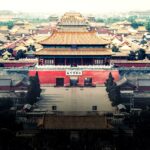Prepare to embark on a captivating journey through the annals of time as we delve into the profound mysteries surrounding the invention of one of humanity’s most transformative creations: paper. In this riveting article, we will unravel the enigma that shrouds the empire or dynasty that bore witness to the birth of this extraordinary invention. As an accomplished historian and expert in ancient civilizations, I will guide you through the labyrinth of historical contexts and archaeological findings, shedding light on the empire or dynasty that played a pivotal role in unleashing the power of paper upon the world. Brace yourself for an exploration of profound significance as we unveil the secrets and unveil the transformative impact of this remarkable ancient invention.
Which Empire or Dynasty Witnessed the Invention of Paper?
In the vast realm of ancient civilizations, one particular empire stands out for its groundbreaking invention that would revolutionize the way information was recorded and disseminated. Which empire or dynasty witnessed the invention of paper? To answer this intriguing question, we must delve into the realms of ancient China, where a remarkable golden age unfolded during the Han Dynasty.
During this period, around 100 BCE or possibly 105 CE, a significant development occurred with the creation of paper. Cai Lun, an esteemed Chinese official in the Imperial court, is credited with this remarkable invention. He devised a unique blend of materials, including mulberry fibers, rags, and hemp waste, which were pulverized and then mixed with water to form a pulp. This pulp was then pressed and dried, resulting in thin, lightweight sheets that we now know as paper.
The Han Dynasty witnessed the invention of paper, marking a pivotal moment in history when the written word gained an easily portable and accessible medium for transmission. This breakthrough propelled China’s cultural and intellectual progress, transforming the way information was recorded, stored, and shared.
Before paper’s advent, various materials such as bark, silk, wood, and leather were used for writing, but none offered the versatility, convenience, and affordability that paper could provide. With paper’s introduction, the art of writing flourished, and it found diverse applications in ancient Chinese society.
“The invention of paper during the Han Dynasty revolutionized the world of writing and communication, bridging the gap between elite scholars and the general population.”
In addition to its primary purpose as a writing surface, paper found its way into countless aspects of day-to-day life. It served as a valuable resource for wrapping objects, a medium for calligraphy and record-keeping, and even made its way into innovative uses like toilet paper, tea bags, and napkins. Paper had indeed become an essential commodity throughout China’s Golden Age.
The advent of paper during the Han Dynasty was not only a significant accomplishment in itself but also one of the four great inventions of early China. Alongside inventions such as printing, compasses, and gunpowder, paper played a central role in shaping the course of human history.
Following its invention, the use of paper gradually spread outside of China, reaching the Middle East and Europe. Its introduction paved the way for the dissemination of knowledge and ideas across boundaries, connecting distant societies, and sharing cultural advancements.
It was during the subsequent Song Dynasty that the demand for paper soared. This surge led to the invention of new types of paper tailored to various needs. For instance, books on art and literature required a smoother surface, prompting the development of high-quality paper. In contrast, administrative documents required durable paper capable of withstanding wear and tear.
In conclusion, the Han Dynasty witnessed the invention of paper, forever altering the course of human civilization. With its invention, information became more accessible, knowledge could be preserved and shared, and the written word achieved newfound mobility. From its humble beginnings in ancient China, paper spread like wildfire, igniting the flames of progress and transforming the world’s intellectual landscape.
“Through the ingenuity of Cai Lun and the Han Dynasty’s golden age, the invention of paper ushered humanity into an era of unprecedented connectivity, communication, and cultural exchange.”
According to historical accounts, one of the most influential empires that witnessed the invention of paper was the Tang Dynasty. This remarkable civilization, which ruled over China from 618 to 907 AD, created an environment conducive to innovation and progress. During the Tang Dynasty, papermaking techniques were refined and transformed, leading to the development of a material that would revolutionize communication and knowledge dissemination. If you’re curious to learn more about which empire or dynasty witnessed the invention of paper, click here for fascinating insights and intriguing historical facts.
All China’s Dynasties: A 5,000-Year Journey Through History
[youtube v=”fFNzX3tYTXU”]
Chinese history, spanning over 5,000 years, has been shaped by its great rivers—the Yangtze River Valley in the south and the Yellow River in the north. In ancient times, these fertile plains surrounding the rivers supported large populations and their agricultural endeavors. This enabled Stone Age cultures to advance, cultivating various crops and domesticating animals.
During these early times, vulnerability to the flooding of these great rivers posed a significant challenge. However, the semi-mythical Xia dynasty, led by a king skilled in irrigation techniques, protected cities from floods and increased crop yields. This gave rise to the first emperors, who ruled over multiple peoples and claimed the Mandate of Heaven.
The Xia dynasty was eventually conquered by the Shang dynasty, known for their warlike nature and their establishment of the Bronze Age in China. They were the first to widely use writing and incorporated vast numbers of slaves into their armies. Later, the Zhou dynasty, aided by Shang slaves defecting to their cause, brought about new institutions and philosophies—most notably Taoism and Confucianism.
Subsequently, China witnessed a time of flourishing states and quasi-independent regions paying homage to a single emperor. This era was marked by constant warfare and the emergence of the dominant Qin state. Qin Shihuang, the first ruler of a unified China, ordered the burning of books and executed scholars to establish a single national identity and history. The Great Wall of China and other monumental projects defined his reign.
Following Qin Shihuang’s death, the Qin Empire descended into chaos and rebellion. The Han dynasty stepped in to consolidate power and maintain a unified realm. The Han period witnessed scientific advancements, the export of silk, and the expansion of the empire westward along the Silk Road. This era is often considered China’s first golden age.
However, dynastic unity was short-lived as the Han dynasty split into three, leading to the domination of warlords and a period known as the northern and southern dynasties—characterized by dark ages, war, and barbarian incursions. The short-lived Sui dynasty unified these fragmented states, and the succeeding Tang dynasty saw an era of stability, scientific progress, and cultural refinement—considered the zenith of Chinese civilization.
Eventually, the Tang dynasty declined, and China once again plunged into chaos. The Song dynasty emerged and unified the country, bringing technological advancements such as the compass, gunpowder, and mass printing. Their achievements ushered in an age of enlightenment, which ultimately ended when the Mongols invaded. Under Kublai Khan’s rule, the Yuan dynasty controlled the entire Silk Road, fostering a diverse exchange of culture and goods.
The Ming dynasty succeeded the Yuan and was characterized by prosperity, art, and literature. However, it was later supplanted by the Qing dynasty, which started as a golden age but ended tragically due, in part, to the British obsession with tea. The British flooded China with opium, resulting in conflicts and China’s isolation from the West.
In 1911, the last emperor of China was deposed, leading to the establishment of the Republic of China and eventually, the People’s Republic of China.
Throughout its history, China has endured the rise and fall of various dynasties, each leaving its mark on the country’s culture, institutions, and people. From the ancient brilliance of the Xia dynasty to the prosperous days of the Ming dynasty, China’s dynastic journey reflects its enduring spirit and rich heritage.
“China’s rich history is a testament to the resilience and adaptability of its people. From the technological achievements of the Han dynasty to the cultural refinement of the Tang dynasty, each era has contributed to the incredible legacy that we see today.”
FAQ
Question: When was paper invented?
Answer: Paper was invented during the Han Dynasty in ancient China. The exact date of its invention is debated, with some sources suggesting it was around 100 BCE and others stating it was around 105 CE.
Question: Who is credited with the invention of paper?
Answer: Cai Lun, a Chinese official working in the Imperial court during the Han Dynasty, is credited with the invention of paper.
Question: What materials were used for writing before paper was invented?
Answer: Before the invention of paper, various materials such as bark, silk, wood, and leather were used for writing.
Question: What were the main uses of paper in ancient China?
Answer: Paper had various uses in ancient China, including wrapping, writing, and even as toilet paper, tea bags, and napkins.
Question: What impact did the invention of paper have on the world?
Answer: The invention of paper had a transformative impact on the world. After its invention, paper spread to the Middle East and Europe, revolutionizing the way information was recorded, shared, and preserved. The demand for paper grew substantially during the Song Dynasty, leading to the invention of new kinds of paper.
- Medieval Houses: A Social History Through Architecture - April 29, 2025
- Unlock Senior Perks: How Old is a Senior Citizen?Complete Guide - April 29, 2025
- Happy Patients: Tech Solutions for Better Healthcare - April 29, 2025
















